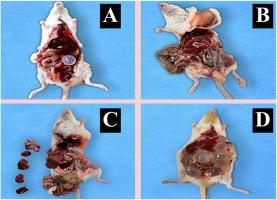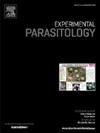研究姜黄素纳米胶囊对包虫病感染小鼠的治疗效果。
IF 1.6
4区 医学
Q3 PARASITOLOGY
引用次数: 0
摘要
背景/目的:囊肿的主要治疗方法是手术,包括切除囊肿和使用适当的化学药物。中草药作为传统药物的一种可行而安全的替代品,已经越来越受到人们的欢迎。使用纳米胶囊来克服姜黄素等草药在生物利用度方面的难题,可能会很有优势。本研究旨在深入探讨姜黄素纳米胶囊治疗包虫病的有效性:方法:将一定量的脂肪酸辛酸钠(SC,0.09 克)和 F127(0.009 克)溶于 1%(w/w)的丁酸乙酯油溶液和 pH 值为 7.4 的磷酸盐缓冲盐水(PBS)中,在剧烈搅拌下,以固定的丁酸乙酯与表面活性剂摩尔比 10 和最终总体积 50 毫升为条件,开发出了姜黄素负载的水包油表面活性剂型生物相容性纳米胶囊。感染 5 个月后,45 只小鼠被分为 6 组。第 1、2 和 3 组每天用姜黄素纳米胶囊(0.5、0.25、0.125 毫克/毫升)治疗一个月。第 4 组接受姜黄素(0.5 毫克/毫升)治疗,第 5 组接受阿苯达唑(150 毫克/千克)治疗,第 6 组为未接受治疗的阴性对照组(仅接受生理盐水)。对囊肿的物理特征,包括大小和重量进行了详细分析:结果:纳米囊的平均zeta电位谱为-33.96 mV。在包囊总数方面,三个纳米胶囊组的包囊总数均显著低于姜黄素组、阿苯达唑组和阴性对照组。在囊肿总重量方面,三个纳米胶囊组的囊肿总重量均明显低于姜黄素组和阴性对照组。在囊肿最大尺寸方面,纳米胶囊 1 组和 2 组的尺寸明显小于姜黄素组、阿苯达唑组和阴性对照组:本研究发现,封装对姜黄素的功效有积极影响,是化学药物的一种优越替代品,具有生物优势和环境效益。本文章由计算机程序翻译,如有差异,请以英文原文为准。

Investigating the therapeutic effects of curcumin nanocapsules in hydatid cyst-infected mice
Background/objective
The primary treatment for cysts is surgery, including removing the cyst and administering the appropriate chemical drugs. Herbal remedies have gained popularity as a viable and secure alternative to conventional pharmaceuticals. It may be advantageous to use nanocapsules to overcome the bioavailability challenges associated with herbal remedies like curcumin. The present study aims to provide insights into the effectiveness of curcumin nanocapsules in treating hydatid infections.
Methods
Curcumin-loaded oil-in-water surfactant-based biocompatible nanomicelles were developed from dissolving Curcumin in 1% (w/w) solutions of ethyl butyrate oil by dissolving an amount of fatty acid sodium caprylate (SC, 0.09 g) and F127 (0.009 g), phosphate-buffered saline (PBS at pH 7.4) under vigorous stirring at a fixed ethyl butyrate-to-surfactant molar ratio of 10 and final total volume of 50 mL. The excess of free PHT was eliminated by dialysis for 24 h. Following five months after infection, 45 mice were divided into six groups. Groups 1, 2, and 3 were treated daily with curcumin nanocapsules (0.5, 0.25, 0.125 mg/ml) for one month. Group 4 was treated with curcumin (0.5 mg/ml), group 5 was treated with albendazole (150 mg/kg), and group 6 was the negative control group without treatments (only received saline). A detailed analysis of the cysts' physical characteristics, including their size and weight, has been conducted.
Results
The mean zeta potential spectrum of the nanocapsules was −33.96 mV. Regarding the total cyst numbers, all three nanocapsule groups had significantly lower total cyst numbers than the curcumin, albendazole, and negative control groups. Regarding the total cyst weight, all three nanocapsule groups had a significantly lower total cyst weight than the curcumin and negative control groups. Regarding the cyst with the maximum size, nanocapsules groups 1 and 2 had a significantly smaller size than the curcumin, albendazole, and negative control groups.
Conclusion
The current study found that encapsulation positively affects curcumin efficacy as a superior alternative to chemical drugs, offering both biological advantages and environmental benefits.
求助全文
通过发布文献求助,成功后即可免费获取论文全文。
去求助
来源期刊

Experimental parasitology
医学-寄生虫学
CiteScore
3.10
自引率
4.80%
发文量
160
审稿时长
3 months
期刊介绍:
Experimental Parasitology emphasizes modern approaches to parasitology, including molecular biology and immunology. The journal features original research papers on the physiological, metabolic, immunologic, biochemical, nutritional, and chemotherapeutic aspects of parasites and host-parasite relationships.
 求助内容:
求助内容: 应助结果提醒方式:
应助结果提醒方式:


